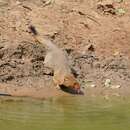en
names in breadcrumbs


Nothing approaching a consensus has emerged regarding the taxonomy of G. sanguinea and its subspecies. In most of the existing literature, it is referred to as Herpestes sanguineus, of the subfamily Herpestinae, part of the family Viverridae.
Perception Channels: tactile ; chemical
As a single species, G. sanguinea is widespread and not endangered. Little reliable information exists about most of its subspecies. As G. sanguinea is subject to the same pressures as its African herpestid and viverrid relatives, some of which are endangered, it is likely that some subspecies are threatened with extinction.
IUCN Red List of Threatened Species: least concern
G. sanguinea is believed to be an important vector for rabies in East Africa. (Hinton, 1967) They will also kill domestic poultry when available. Mongooses have been the targets of extermination efforts for these reasons.
They help to control insect and rodent pests. For this reason, other species of mongoose have been introduced around the world, but often do more harm than good.
G. sanguinea are opportunistic feeders. Insects make up the largest portion of the diet, supplemented by lizards, rodents, snakes, birds, amphibians, and fruit. (Smithers, 1983) They will eat carrion and eggs, which they crack open by propelling with the forefeet backward between the hind feet against a hard object. Like other mongooses, they are capable of killing large, venomous snakes, which they then eat, but these are not a significant portion of their diet.
Galerella sanguinea has as many as 40 subspecies, which are distributed throughout savanna and semiarid regions of subsaharan Africa. They are not known to inhabit extreme desert or the densely forested parts of equatorial Africa. (Taylor, 1975)
Biogeographic Regions: ethiopian (Native )
Slender mongooses are not picky when it comes to habitat, inhabiting a wide variety of biomes within their broad geographic range. They seem to avoid dense tropical forest, but will live anywhere from "arid hills on which there is only a little stunted vegetation, or thick scrub or low forest, or level sandy plains whether comparatively open, bush-covered or lightly wooded." (Hinton, 1967)
Terrestrial Biomes: savanna or grassland ; forest ; scrub forest
Average lifespan
Status: captivity: 12.6 years.
Body length, 27.5-40 cm; tail length, 23-33 cm.
As its common name, the "slender mongoose", implies, Galerella sanguinea is one of the smallest mongooses. Like other mongooses, it has short legs and a long, slim body. On average, males are 10-20% larger than females. They are usually reddish, yellowish or gray in color, more rarely dark brown, often speckled, and have a black or red tip of the tail. Ventral pelage ranges from pale yellowish-brown to white. There is considerable variability in coloration among subspecies, usually correlated with soil color for camouflage. They have finer, silkier fur than other African herpestids.(Parker, 1990)
The dental formula for G. sanguinea is 3/3, 1/1, 4/3, 2/2 = 38 (most closely related species have 4 lower premolars) (Taylor, 1975). The first upper premolar is small and occasionally absent; the carnassials are robust. It has five toes on both fore and hind feet.
Range mass: 350 to 900 g.
Average mass: 500 g.
Other Physical Features: endothermic ; bilateral symmetry
Average basal metabolic rate: 2.202 W.
A dominant male's range generally includes the range of several females. Scent cues inform him when a female is in estrus, and a brief courtship occurs. In Galerella sanguinea, the male takes no part in the raising of the young. (Macdonald, 1984)
Timing of pregnancy varies depending on the location and the subspecies, but reproductive activity seems to be concentrated in the period from October to April. Gestation period is believed to be 60-70 days. 2 young are usually born per pregnancy. (Taylor, 1975)
G. sanguinea are believed to reach sexual maturity between 1 and 2 years of age, and may live to be 10 years old.
Key Reproductive Features: gonochoric/gonochoristic/dioecious (sexes separate); sexual
Average gestation period: 65 days.
Average number of offspring: 2.
Average age at sexual or reproductive maturity (male)
Sex: male: 365 days.
Average age at sexual or reproductive maturity (female)
Sex: female: 365 days.